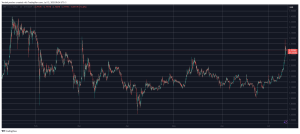The relatively small size of the Latin American crypto-economy compared to other regions can be misleading since it doesn’t accurately represent the high levels of adoption and awareness of crypto at the grassroots level. Three LATAM countries – Brazil, Argentina, and Mexico – are ranked in the top 20 of Chainalysis’ annual Global Crypto Adoption Index, while research from Circle suggests that more than half of consumers in the region have made a purchase with digital currencies.
Along with a booming exchange and payments sector featuring crypto giants such as Mercado Libre and Bitso, Latin America is also home to a thriving group of home-grown Web3 ecosystems that are developing tools and solutions focused on the specific needs of LATAM users and operating within local rules and infrastructure. Here are four of the leaders.
Patex
Founded in 2014, Patex has expanded its vision beyond its original focus as an exchange to become a comprehensive blockchain solution for the LATAM region and a bridge between regulators and users. Patex Network comprises a Layer 2 blockchain, crypto exchange, wallet, and educational platform.
The blockchain is a custom implementation forked from Optimism and developed for issuing and trading CBDCs and regulated cryptocurrencies. C-Patex, the exchange platform from which the Patex ecosystem developed, has an established user base of over 100,000 who trade around $10 million in 30-day trading volumes.
In 2023, Patex secured a $10 million strategic investment from Acura Capital, one of Brazil’s largest investment firms, which valued the project at $100 million. The project also won the title of “Best LATAM Blockchain Ecosystem of the Year 2023” at the prestigious Future Innovation Summit in Dubai.
The project’s mainnet token is being released on three decentralized launchpad platforms over a week at the end of February. First up, $PATEX will be available on WePad from February 27 before going live for six days on DAOMaker from February 28 and then launching on ChainGPT Pad on February 29.
Rootstock
Another of Latin America’s well-established Web3 projects, Rootstock is an EVM-compatible smart contract platform built as a Bitcoin side chain. It’s merge-mined with Bitcoin, meaning it shares the robustness of the proof of work consensus. The original project was founded in 2016 as RSK and was later renamed Rootstock.
Over recent years, Rootstock has been developing its infrastructure with ready-made solutions for implementing payments, identity, and marketplace services on its platform. It now also has its own DeFi ecosystem, with projects including stablecoin Money on Chain, one-stop DeFi shop Sovryn, and cross-chain wallet Liquidity operating on the Rootstock network.
Recently, Uniswap also went live on the platform, strengthening the connection between the Bitcoin blockchain and the Ethereum ecosystem.
Xcapit
Xcapit is a financial services ecosystem leveraging blockchain and AI, which offers multiple solutions tailored to Latin American markets. These include a wallet, credit processing, and lending infrastructure, and a tokenization platform. The project is focused on education, technology, gamification, and purpose-driven investments. It claims to be the only crypto wallet to have achieved the status of “digital public good” by the Digital Public Goods Alliance and is also a member of UNICEF’s innovation fund.
Xcapit is a former winner of the Santander X Global Challenge, earning it a place in the Santander X 100, a global community of startups and scale-ups. The project has also established partnerships with universities in Argentina and Mexico to teach students about blockchain technology and digital finance, as well as a charitable organization providing aid to vulnerable groups.
LaChain
LaChain is the newest project on this list, having only launched in 2023. It’s a Layer 1 network launched collaboratively by a consortium of Latin American blockchain companies, including payments provider Ripio and local stablecoin issuer Num Finance, among others.
Ripio, which has eight million users across the region, launched its own US-dollar pegged stablecoin, UXD, on the network shortly after it launched last summer. The launch aims to meet demand for a solution that can combat high inflation in the region, protecting assets against fluctuating local currencies. Latin America has some of the highest rates of stablecoin adoption for this reason.
LaChain is built using Polygon Supernets, meaning it offers EVM compatibility with high scalability and low transaction fees. However, it operates as a standalone blockchain network with its own validator set.
The economic challenges of the Latin American region aren’t easily overcome. However, adoption metrics illustrate that the opportunities of Web3 are appealing to those at the grassroots level, and innovators are increasingly willing to meet the growing demand.
Disclaimer: This article is provided for informational purposes only. It is not offered or intended to be used as legal, tax, investment, financial, or other advice.




















